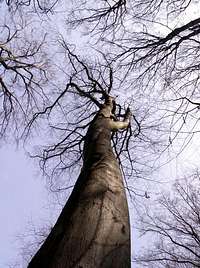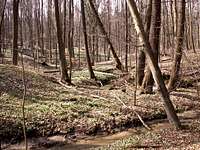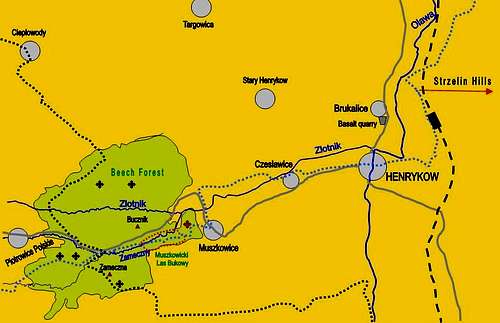Ravine and its stream.........
![Beech...]()
![Travertine...]()
![Daphne...]()
![Fragment...]()
A nature reserve called Muszkowicki Las Bukowy (Muszkowice Beech Forest, see a red broken line on a map) is situated westward from the village of Henryków, nearby another village, Muszkowice. The reserve is a small part of a larger beech forest growing on two hills, Zameczna and Bucznik. This area is a part of Sudetes Foreland in Poland, the Bielawa - Niemcza Hills. In the forest there were discovered megalithic graves of the Lusatian Culture (Bronze Age/Iron Age; see black crosses on a map). In the reserve there are protected rare plants and rich vegetation of beech, oak, ash, hornbeam and alder forest. Two streams, Złotnik and Zameczny, erode deeply soft loess soils creating very picturesque ravines between hills. Water flows partly on stony bottom composed of local gneisses and mica-slates or on postglacial pebbles. In addition, on steep slopes there are several small springs dissolving Ca-minerals which form a travertine. Pieces of traverine we can find in the Zameczny stream. Many beautiful plants are blooming now, early spring (March 27, 2010). There are rich carpets of
Leucojum vernum and
Galanthus nivalis. Also other plants start these days to bloom:
Corydalis cava,
Daphne mezereum,
Pulmonaria obscura,
Anemone nemorosa,
Anemone ranunculoides,
Chrysosplenium alternifolium,
Asarum europaeum,
Arum maculatum,
Lathyrus vernus. Very old beeches fall down and next they are overgrown by mosses, lichens, ferns and mushrooms. Many molluscs, beetles and others small animals are living in microhabitats on decaying tree. Landscape of the area is really mountainous and some plants living here are considered as characteristic for mountains, e.g.
Dryopteris dilatata,
Rubus hirtus,
Acer pseudoplatanus,
Veronica montana,
Sambucus racemosa or
Prenanthes purpurea.
South- and westward of Henryków there are extensive wet meadows where many amphibians live. Such a habitat is very suitable for white and black storks nesting in the vicinity. Going westward from the Muszkowice village we ascend a small hill called the Chapel Hill (a red cross on a map) with St. Ann’s Chapel (erected in 1707) and stations of the Christ’s Passion Way. Through this area we can trek along two trails, blue and black.
The village of Henryków is very known in Poland because of its beautiful Cistersian monastery (XIII/XIV c.). A little northward of Henryków there is another famous small village, Brukalice. In this village in the XIIIth century a Czech Boguchwał and his wife lived (see Yatsek's comment below and his addition pages). Boguchwał told to wife a sentence
“Day ut ia pobrusa a ty poziwaj” (Let me to mill and you rest a little) which is written in “Księga Henrykowska” (The Henryków Book dated 1268-1273) by abbot Peter from the monastery. This book is some kind of a monastery chronicle.
The sentence is the first written Polish one known in literature.In the village of Brukalice also an old basalt quarry is localized, where I determined in small basalt cavities several minerals, e.g. calcite, chabazite, phillipsite, thomsonite and montmorillonite.
I add here a comment written by Yatsek, SP member:
As you mention in the text for the album,the guy who spoke these words is -earlier in the same book (written in C13) - called "a Czech". Surely he was a (Western) Slav though.








Comments
Post a Comment